Phở is like Vietnam’s edible pride flag – the dish everyone knows us for. That’s why I went with “Savour the Phở” for my blog name, even though, let’s be honest, my heart secretly beats faster for Bún Bò Huế 😂.
Today’s recipe? Instant Pot Chicken Phở. Nope, it’s not the old-school way grandma does it, but trust me – this shortcut still brings that soulful, Hanoi-style flavor to your bowl.
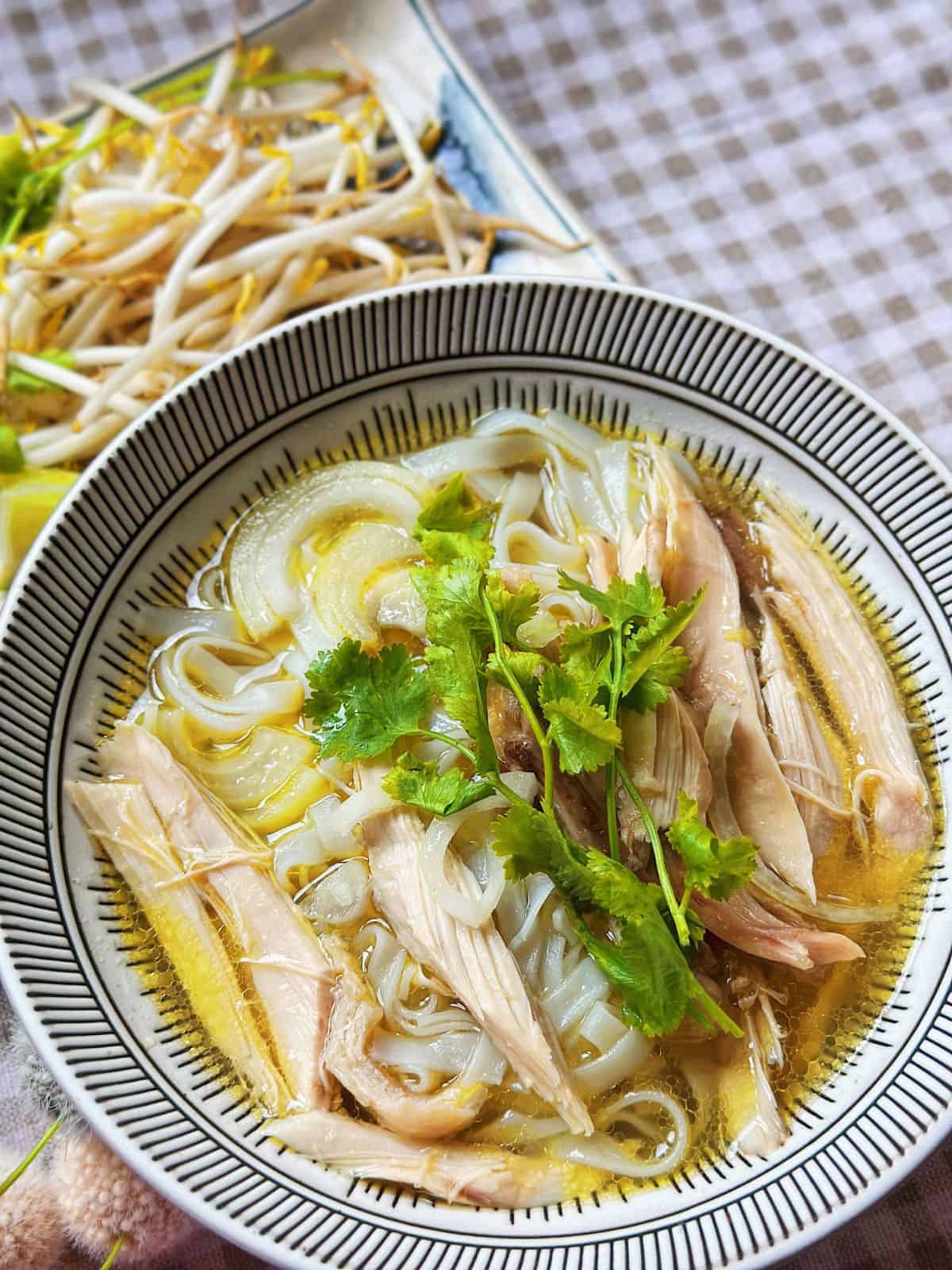
When in Hanoi, eat Phở.
Hanoi, Vietnam’s graceful old soul, is a foodie wonderland. Every corner hums with the smell of something sizzling, simmering, or brewing. As a girl from the South, I’ll admit it – Hanoi’s cuisine has a special charm that totally wins me over.

Of course, Hanoi is more than just Phở. There’s the smoky-sweet Bún Chả (seriously addictive grilled pork with rice noodles), the iconic Chả Cá Lã Vọng (turmeric fish with dill that’s practically a rite of passage here), and Cà Phê Trứng – egg coffee so creamy it’s basically dessert disguised as caffeine.
I’ll always choose Hanoi’s Chicken Phở, but when it comes to beef? The southern version wins my heart with its rich broth, beef balls, and mountain of fresh herbs. (Curious about the difference? I’ve broken it all down in my Northern vs. Southern Phở guide.)
And don’t stop at the classics – Vietnam’s Phở family is way bigger than just beef and chicken:
- Phở Bò Sốt Vang (beef stew-style Phở)
- Phở Trộn (dry Phở with a tangy-sweet soy sauce)
- Phở Áp Chảo (stir-fried Phở noodles)
- Phở Sa Tế (spicy Phở for chili lovers)
If Hanoi taught me anything, it’s that you don’t “just eat” Phở – you fall in love with it.
What You Need for Hanoi-Style Chicken Phở
The Spice Story
A lot of folks swear by those ready-made Phở spice packets – and honestly, there’s no shame in that. But when I’m chasing that true Hanoi vibe, I like to craft my own spice mix.
Here’s the thing about Phở in Vietnam: if you’ve slurped a bowl in Hanoi, you’ll notice it’s not swimming in heavy cinnamon or star anise flavors. Nope. The soul of that broth comes from charred ginger, shallots, onions, and peppercorns.
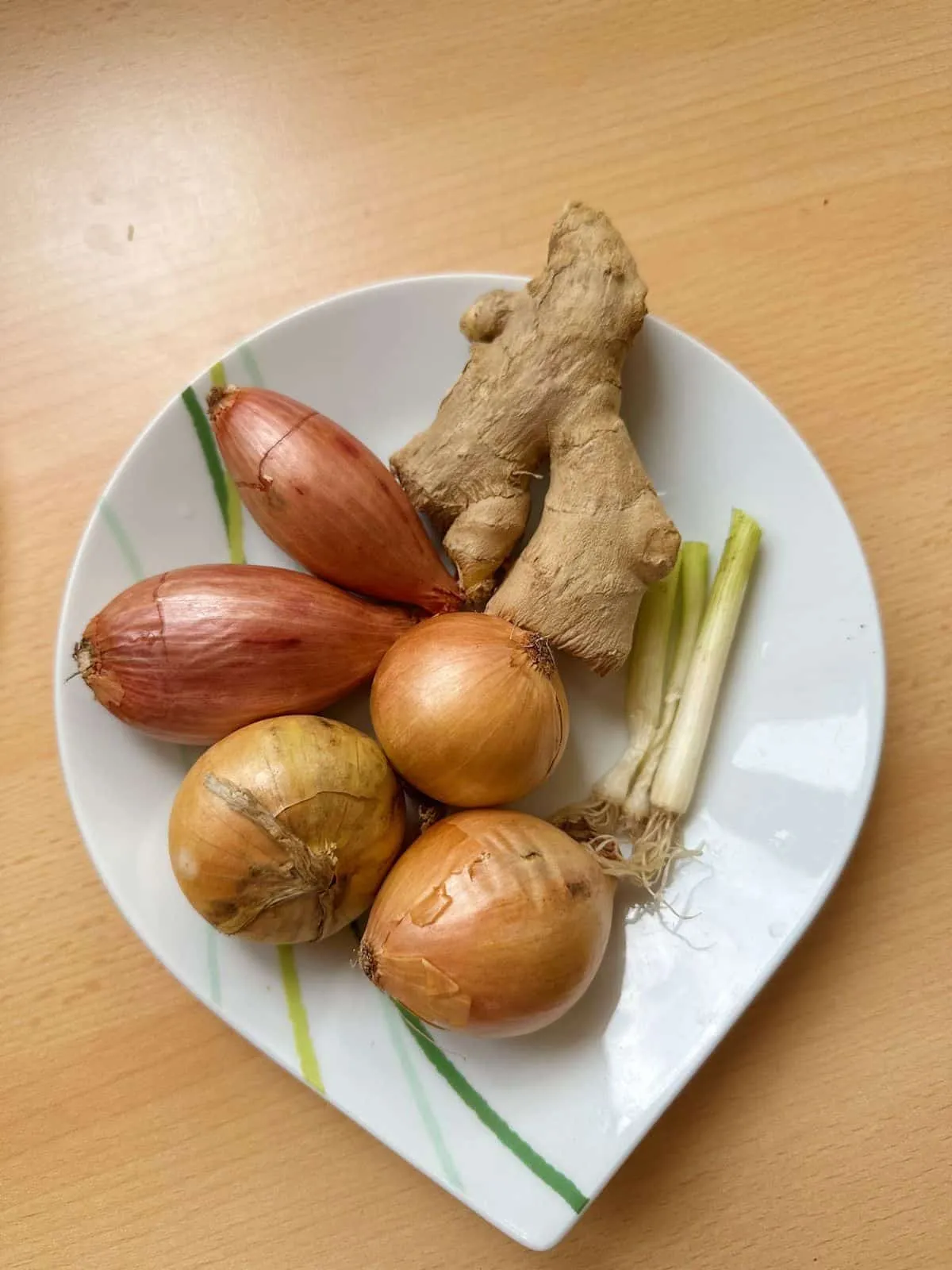
For Chicken Phở, coriander seeds are the real MVP. Hanoi street vendors have this little secret – they toss in coriander roots (or stems) and even scallion roots to add a deeper, almost earthy sweetness to the broth.
And here’s a must-have: lime leaves. They’re the Beyoncé to chicken’s Jay-Z in Vietnamese cooking (hello, Gà Xào Sả Ớt!). No lime leaves? Kaffir leaves will do the job.
Other warm spices – like star anise, fennel, cinnamon, black cardamom, cloves – are more of a “your call” thing for Hanoi-style Chicken Phở. A little pinch adds a whisper of fragrance.

My go-to spice mix for 3.5 liters (3.6 quarts) of broth:
- 3 unpeeled onions
- 2 big unpeeled shallots
- A chubby 10 cm (4-inch) knob of ginger, unpeeled
- ¼ cup coriander seeds
- 1 tbsp white peppercorns (black ones work just fine too).
- 3 lime or kaffir leaves
- Optional: scallion roots, cilantro roots/stems, a touch of fennel, a small cinnamon stick, 1 black cardamom, 2–3 star anise
Chicken
Vietnamese people don’t really go for that melt-in-your-mouth chicken texture. We like it with a bit of spring – the skin should have some bite to it.
In Vietnam, Phở is usually made with Gà Ta – free-range, local hens that have laid eggs once or twice. They’re the gold standard.

In Germany, I’ve learned that an older hen works magic for Chicken Phở. If you’re lucky and live near a Vietnamese or Asian market, you might even find Gà Đi Bộ (walking chicken) – the closest thing to Gà Ta.
Feeling lazy? I sometimes use chicken leg quarters or thighs. It cooks faster, and the flavor still hits the spot. My German boyfriend actually prefers this version (he’s not exactly a fan of “Vietnamese chicken chewiness” 😅). If you go this route, organic or free-range chicken makes a huge difference.
Pork Bones
Yep, you heard me – pork bones in chicken Phở. It’s a classic Hanoi move to crank up the broth’s richness. Some old-school vendors even toss in sá sùng (dried sea sandworms) – a seriously prized secret ingredient that gives the broth its signature depth. It’s one of those hush-hush Phở vendor secrets – if you know, you know.
No pork bones? No worries. Just double down on chicken bones or use a solid, good-quality chicken stock. Plain water will do in a pinch, but you’ll miss that deep, savory magic.
Seasoning
- Fish sauce: Don’t skimp – cheap fish sauce cooked for hours will betray you with a weird sour note. Add fish sauce at the very end, just enough to make the flavors pop.
- Rock sugar: It’s my Southern touch – a little sweetness rounds out the broth. Granulated sugar is fine if you don’t have rock sugar.
- Salt, chicken powder, MSG: This time, I’m sticking with just salt. But chicken powder or a pinch of MSG can be your best friend if your broth needs a flavor boost.
Other Essentials
- Bánh Phở (Phở noodles): Go for the flat ones – that’s how they roll in the North. The thin noodles are more of a Southern thing.
- Garnishes (my Southern “cheat” – Hanoi folks, don’t yell at me!): Bean sprouts, lime wedges, slices of fresh chili (Thai or jalapeño), and my herb dream team – Thai basil, cilantro, and culantro.
- Chili sauce – Sriracha works perfectly.
- Quẩy (Youtiao): In Hanoi, no Phở feast is complete without these golden, crispy Chinese donut sticks for dipping into that hot, silky broth.
- Giấm tỏi (Pickled Garlic in Vinegar): The quiet hero on every Phở table – one spoonful of this tangy, garlicky magic will wake up your bowl like nothing else.
Instructions for Instant Pot Chicken Phở
Step 1: Prepare the Broth
(Skip this if you’re using store-bought chicken stock or just water.)
- Set your Instant Pot to “Sauté” mode. Add the pork bones, a pinch of salt, and enough water to cover. Parboil for a few minutes to get rid of impurities.
- Drain, then wash and rinse the bones until the water runs clear.
- Place the bones back in the pot and fill with water up to the fill line (about 2.5–2.6 liters/2.6 quarts). Add 1 tablespoon of salt.
- Pressure cook: High pressure for 7 minutes (or 5 minutes if using chicken bones). Let it naturally release for 5 minutes.
- Discard the bones. You should now have around 2.6 quarts (2.5 liters) of clean broth.
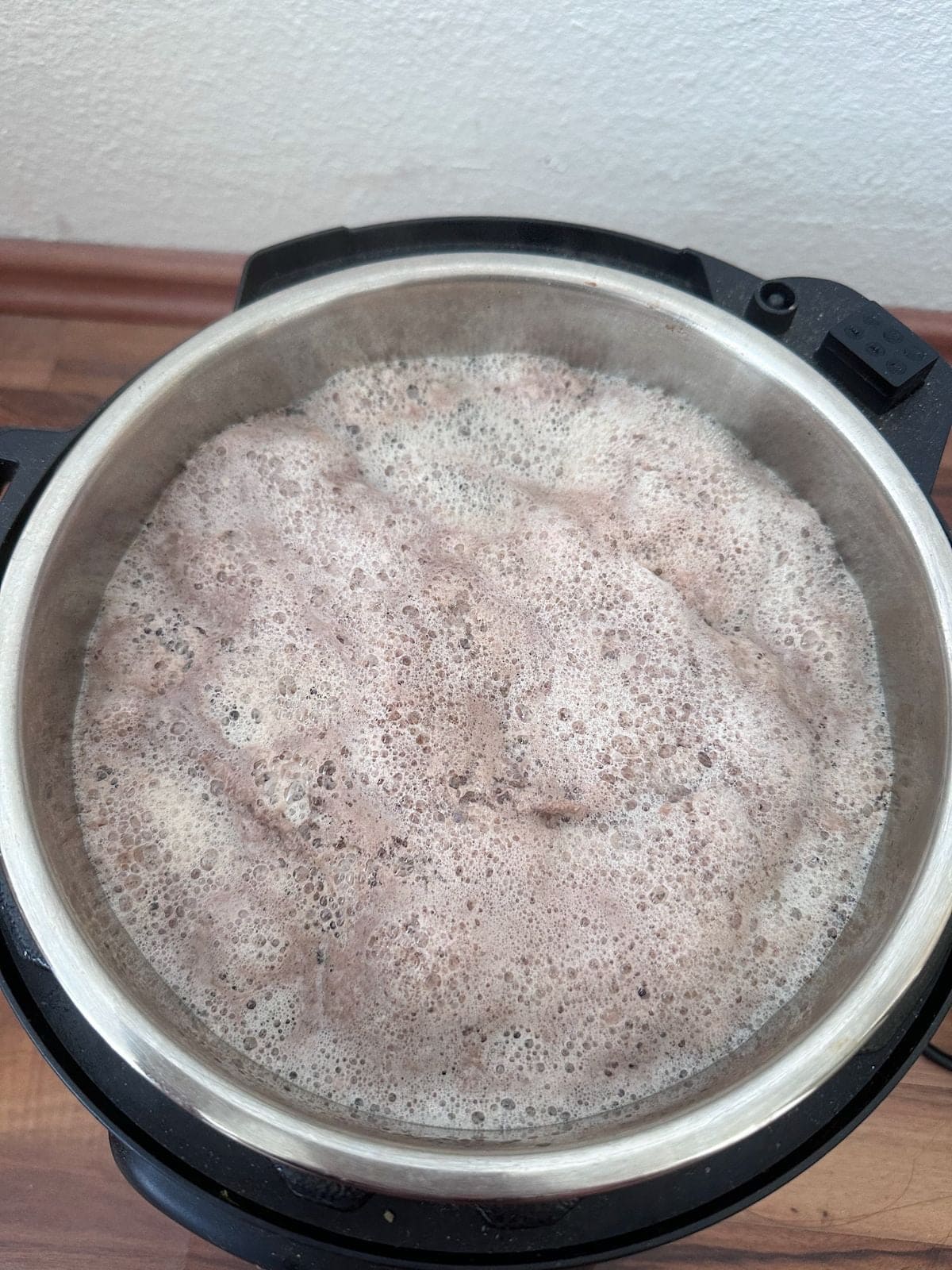
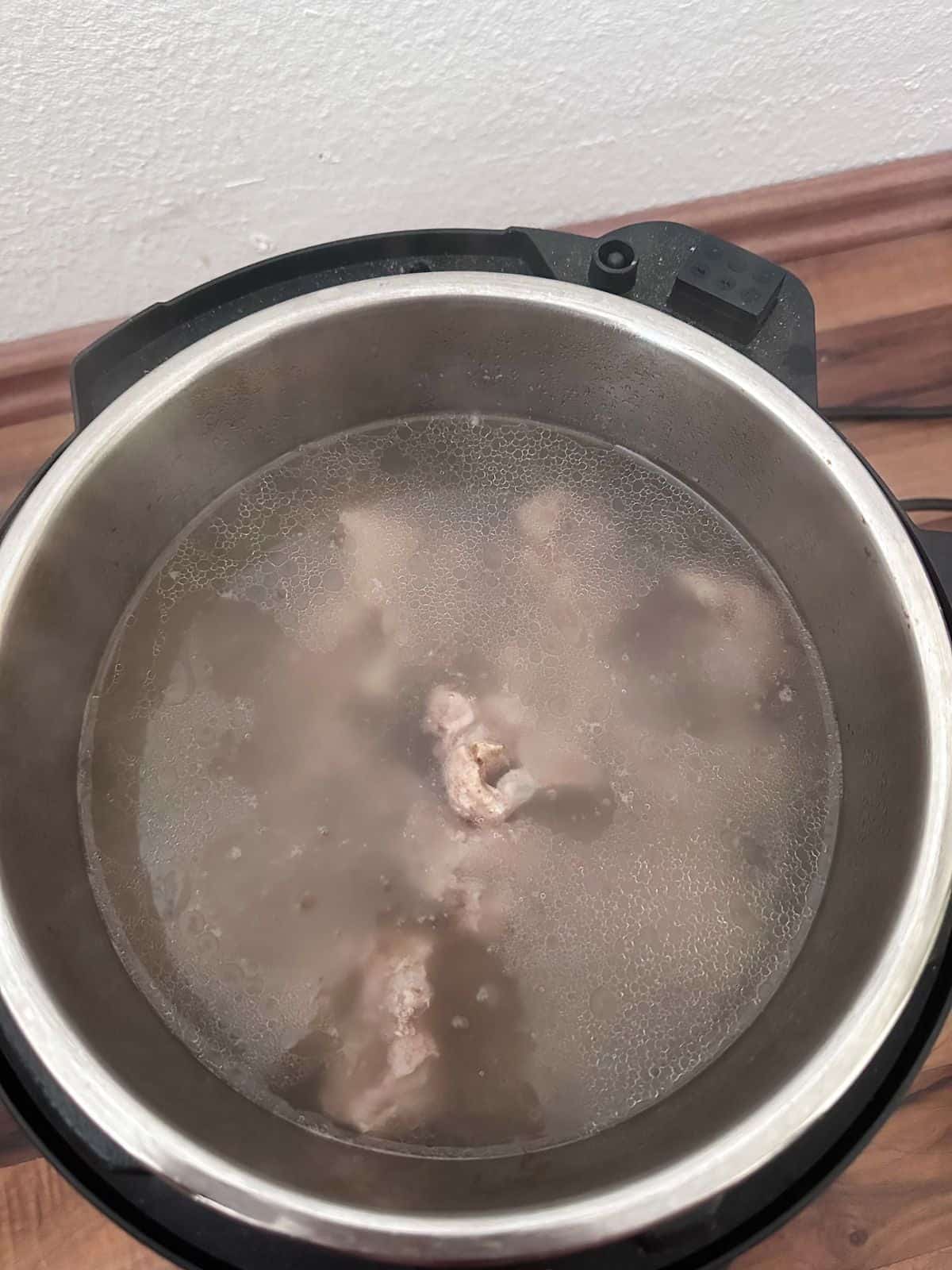
Step 2: Prep the Chicken
- Rub the chicken all over with salt, rinse, and clean it thoroughly.
- Remove the chicken butt (yep, take it off!) and any leftover organs inside the cavity.
- Give it one final rinse and set it aside.
Step 3: Toast & Char the Aromatics
- Slice the ginger into thick pieces and cut the onions in half.
- Char the onions, shallots, and ginger until slightly blackened – an air fryer, oven, or hot stainless steel pan works. Peel off any overly burnt parts.
- Toast the smaller spices (coriander seeds, fennel seeds, cloves, peppercorns) in a dry stainless steel pan until fragrant.
- Toast the larger aromatics (star anise, cinnamon, black cardamom, kaffir leaves, coriander roots, and scallion roots) separately.
- Once cooled, place all spices into tea bags or spice pouches. (You can toss them straight into the broth, but then you’ll have to strain it later.)
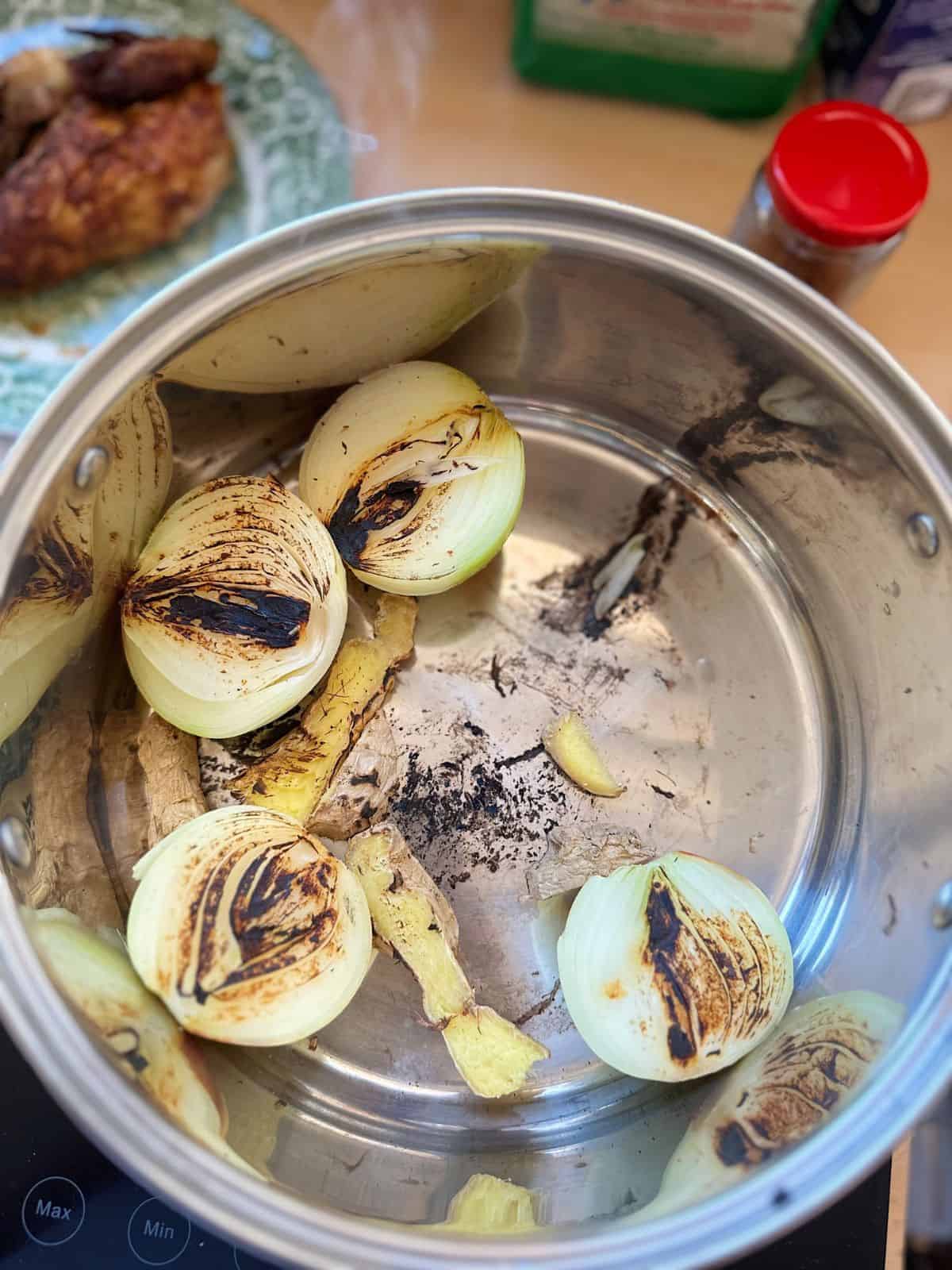
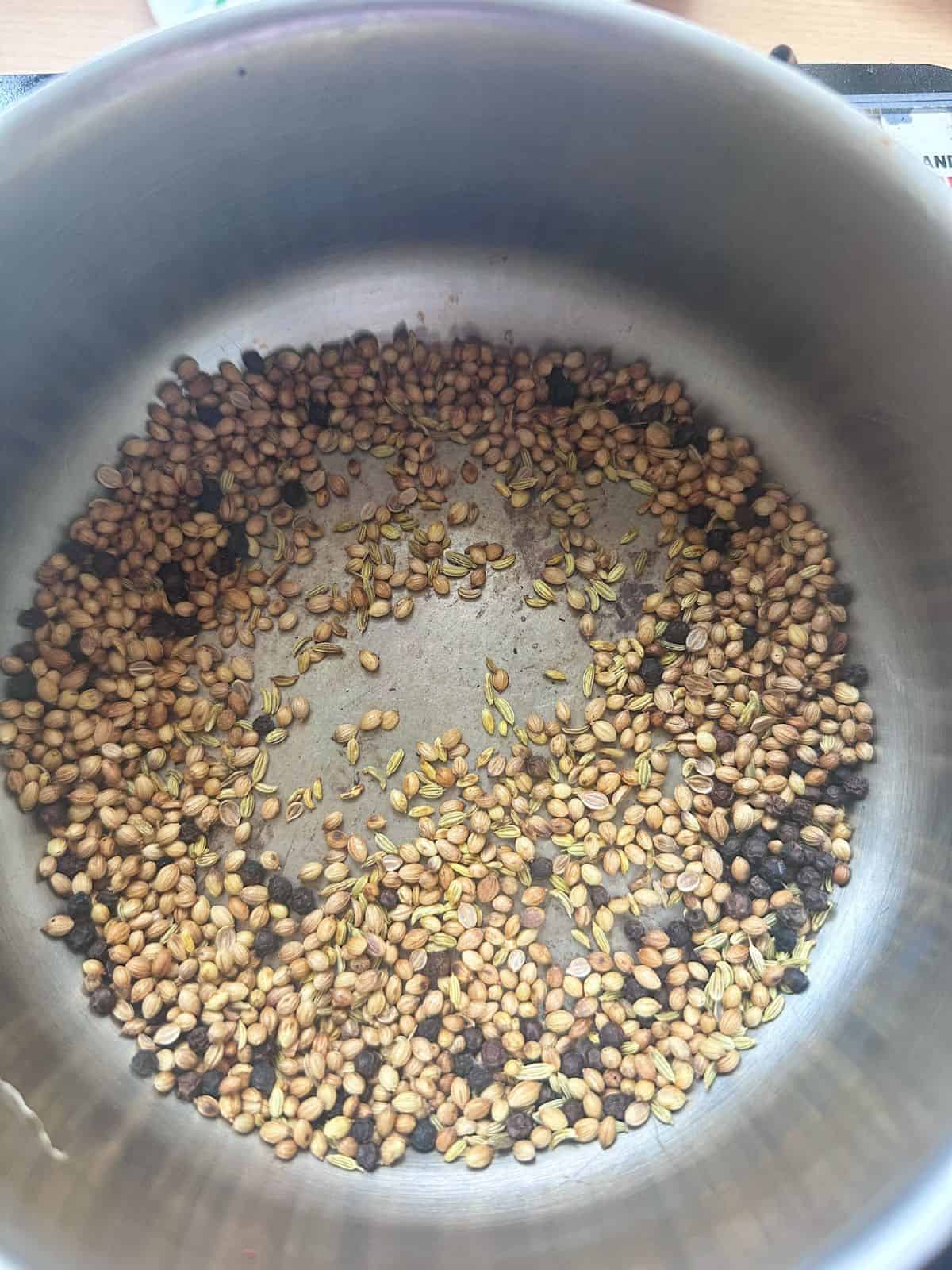
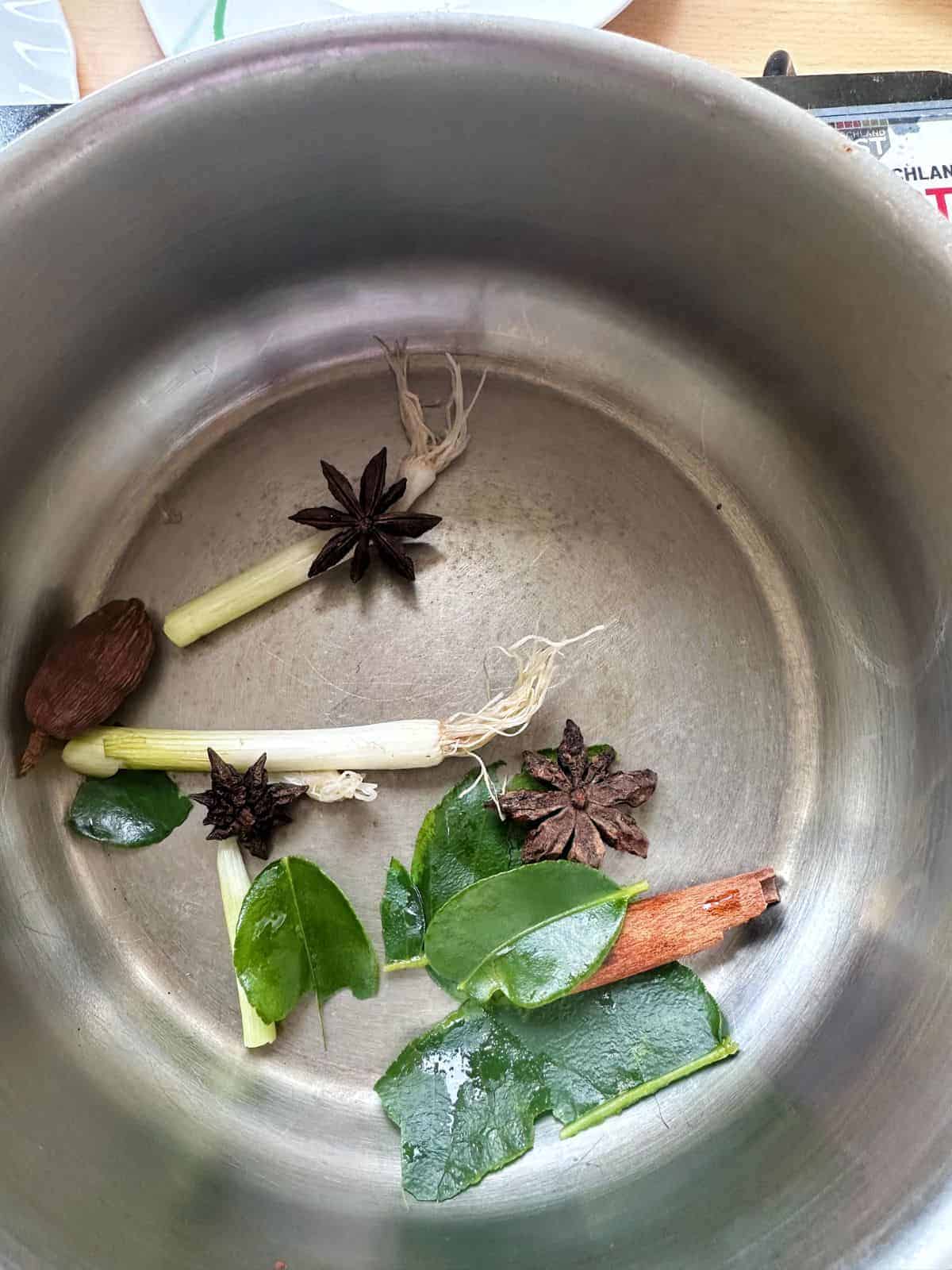
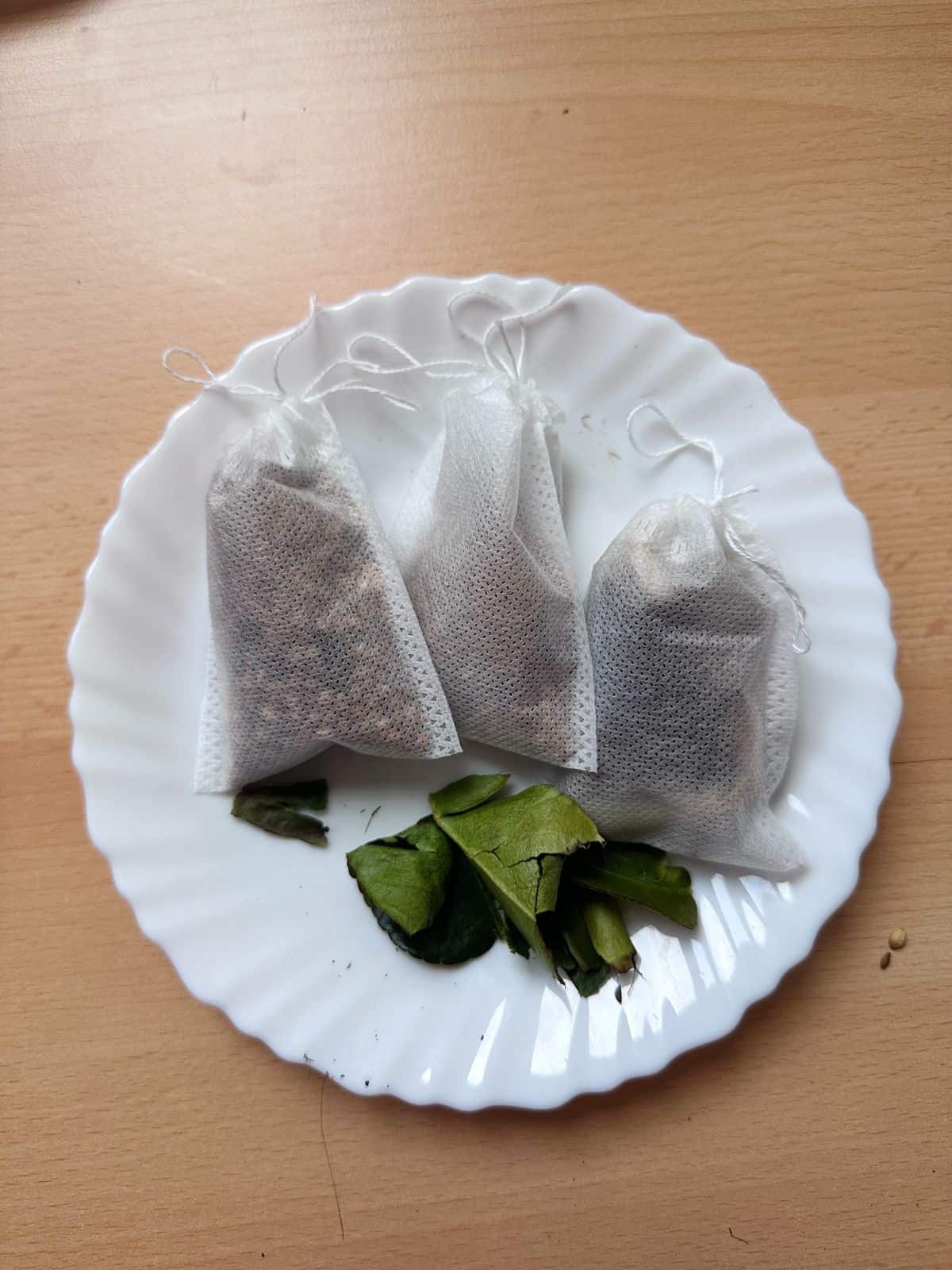
Step 4: Cook the Chicken Phở Broth
- Add the prepared chicken, charred aromatics, and spice bags to your pot of broth.
- Top up with water if needed (to the fill line) and add 1 tablespoon of rock sugar.
- Pressure cook on High Pressure mode:
- For an old hen: 15 minutes, then natural release for 15 minutes.
- For chicken leg quarters or thighs: 0 minutes, then natural release for 10–15 minutes.
- Remove the chicken and set it aside to cool.
- Discard the spice bags, onion, and shallot from the broth.
- (Optional) Add 1 liter (1 quart) of boiling water to dilute if the broth is too rich. This should yield enough broth for 5–6 bowls.
- Season with salt, fish sauce, and chicken powder (plus a pinch of MSG if you like). Make it slightly saltier than you think – the noodles and toppings will tone it down.
Step 5: Assemble the Bowls
- Shred the cooked chicken. Thinly slice a fresh onion.
- Blanch bean sprouts quickly in boiling water.
- Cook the Phở noodles as per package instructions, then rinse under cold water to remove extra starch.
- Divide noodles into bowls. Top with shredded chicken and sliced onion.
- Pour the steaming hot broth over everything.

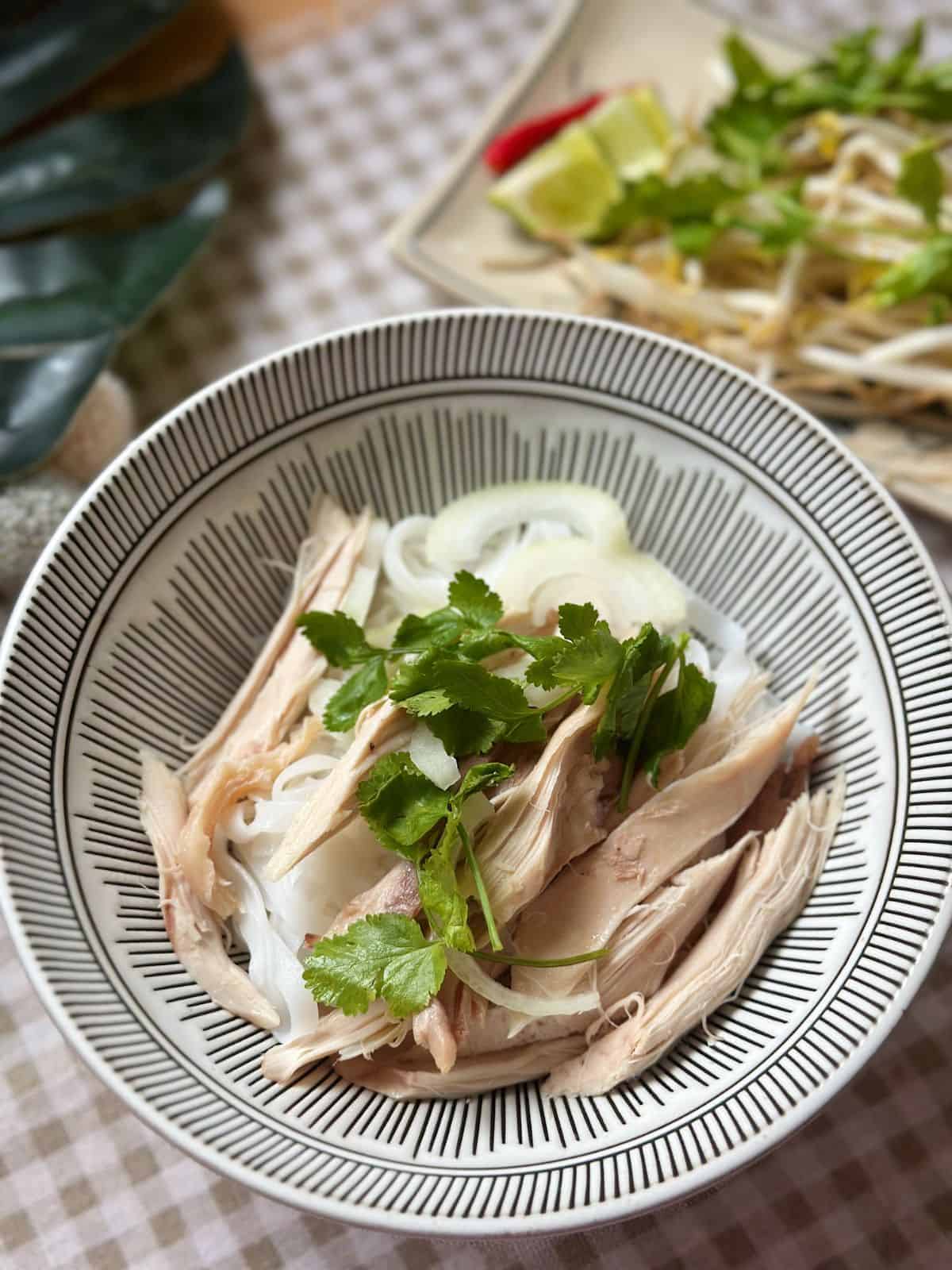
How to Eat Phở Gà (Like a Local)

First things first: sip that broth. It’s the soul of the bowl. Taste it as is, then tweak it to your liking – a squeeze of lime, a dash of fish sauce, or a hit of chili sauce if you want to bring the heat.
Next, toss in the bean sprouts and tear up the herbs. Give them a little dunk so they soften and release all their fragrance into the broth.
When it’s time to dig in, use chopsticks and a spoon – one for the noodles and meat, one for slurping that liquid gold. And heads up: in Vietnam, slurping noodles like you’re eating Japanese ramen is a big no-no. Keep it classy!
In Hanoi, they keep things simple – no bean sprouts, no mountain of herbs, and definitely no hoisin sauce. What they do love? Dipping crispy quẩy (youtiao) into the broth and enjoying it alongside the noodles. Trust me, it’s a game-changer.
Phở Facts You Probably Didn’t Know
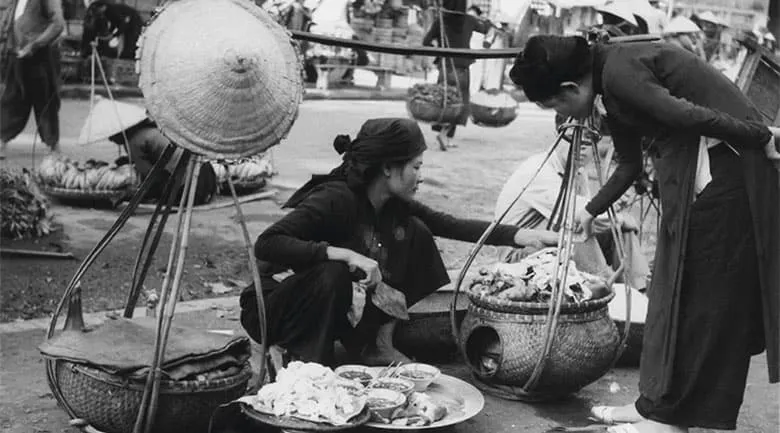
- Phở Gà wasn’t always a thing. It was born during the French colonial era when beef was in short supply on certain days of the week. The clever Beef Phở vendors thought, “Why not try chicken?” – and boom, Chicken Phở was born.
- Beef and chicken Phở are not just the same soup with different meats. Their broths and spices are completely different. In Hanoi, no serious Phở vendor would dare serve both from the same pot – it’s practically a recipe for failure.
- Hanoi vs. Saigon broth. Hanoi’s broth is delicate, subtle, and whisper-light. Saigon broth? Rich, bold, and a little extra – just like the city itself. And of course, Chicken Phở is always lighter than its beefy sibling.
- Breakfast vibes: Up North, Phở and Bánh Cuốn rule the mornings. Down South, we’re less obsessed with Phở – we’ll happily wake up to Xôi Mặn, Hủ Tiếu Nam Vang, or Cơm Tấm instead.
More Easy Asian Recipes for Your Instant Pot

(Vietnamese Beef Stew)

(Vietnamese Sticky Rice with Chinese Sausages)
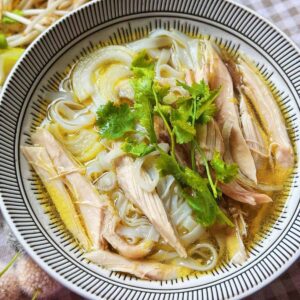
Instant Pot Chicken Pho – Authentic Hanoi Phở Gà
Equipment
- 1 Instant Pot (6-quart / 6 liter)
Ingredients
Pho Spices
- 3 onions (unpeeled)
- 2 shallots (unpeeled)
- 4-inch (10 cm) section fresh ginger (unpeeled)
- ¼ cup coriander seeds
- 1 tbsp peppercorns
- 3 lime / kaffir leaves
- 3 scallion roots (optional)
- A handful cilantro roots / stems (optional)
- 1 tsp fennel seeds (optional)
- 1 small cinnamon stick (optional)
- 1 black cardamom pod (optional)
- 3 star anise pods (optional)
Chicken
- 1 whole free-walking chicken / old hen (or 4 chicken leg quarters)
Broth (optional but highly recommend, you could substitute with the same amount of store-bought chicken stock or water)
- 2.5 lbs pork bones / chicken bones (1.1 kg)
- 2 quarts water (2 liter)
- 1 tbsp salt
Seasonings
- 4 tbsp High-quality fish sauce (to your taste)
- 1 tbsp rock sugar (or 1/2 tbsp granulated sugar)
- 2 tbsp salt / chicken powder (to your taste)
- ½ tbsp MSG (optional)
Other ingredients
- Phở rice noodles (flat rice noodles for Northern Phở)
- Bean sprouts
- Chili (Thai Chili or Jalapeno)
- Lime
- Herbs (Thai basil, cilantro, culantro…)
- Chili sauce (Sriracha)
- Quẩy (Youtiao or Chinese donut sticks) (optional)
Instructions
Prepare the broth (skip this step if you use store-bought chicken broth or just water)
- Parboil the pork bones in water with some salt with the "Saute" mode of your Instant Pot. Wash and rinse the bones until the water runs clear.
- Place the bones back into the pot. Fill the pot with enough water to reach the fill line (should be about 2.6 quarts/2.5 liters). Season with 1 tablespoon of salt. Pressure cook on High for 7 minutes (or 5 minutes for chicken bones), then allow for a natural release for 5 minutes.
- Discard the bones, and you'll have about 2.6 quarts (2.5 liters) of broth.
Prepare the chicken
- Prepare the chicken by rubbing and rinsing it with some salt. Remove the chicken butt and any leftover organs inside the chicken (if present). Rinse the chicken thoroughly.
Toast and char the spices
- Slice the ginger and cut the onions in half.
- Char the onions, shallots, and ginger (you could use an air fryer, an oven, or a stainless steel pan). It's okay if they become slightly burnt. Remove any burnt parts.
- For the smaller spices, such as coriander seeds, fennel seeds, cloves, and peppercorns, toast them together in a stainless steel pan.
- Similarly, toast the other ingredients—star anise, cinnamon, black cardamom, kaffir leaves, coriander roots, and green onion roots—together.
- Once cooled, place all spices into the tea bags. While you could add all of them directly into the broth, you would then need to strain the broth before serving to remove the spices.
Cook the Chicken Pho Broth
- Add the chicken, ginger, onions, shallots, and all spices to the pot of broth. If necessary, add more water to reach the fill line. Season with 1 tablespoon of rock sugar.
- On "High Pressure" mode:– For an old hen: Cook for 15 minutes, then allow for a natural release for 15 minutes.– For chicken leg quarters/thighs: Cook for 0 minutes, then allow for a natural release for 10-15 minutes.
- Remove the chicken and set it aside. Discard the spice bags, onion, and shallot from the broth.
- The broth is now rich and bursting with umami flavor. If desired, you can dilute it with 1 quart (1 liter) of boiling water (this yields 5-6 bowls of Pho).
- Season the broth with salt/chicken powder, fish sauce and MSG (optional). Remember to make it slightly saltier than your preference, as it will be diluted when served with the rice noodles and bean sprouts.
Assemble
- Shred the chicken and slice the onion. Blanch the bean sprouts.
- Cook the pho noodles as per the instructions. Rinse them thoroughly to remove the starch.
- Place the rice noodles in a bowl, then add the shredded chicken and sliced onion on top. Pour the broth over the ingredients.
- Enjoy with a squeeze of lime, bean sprouts, herbs, and chili sauce.


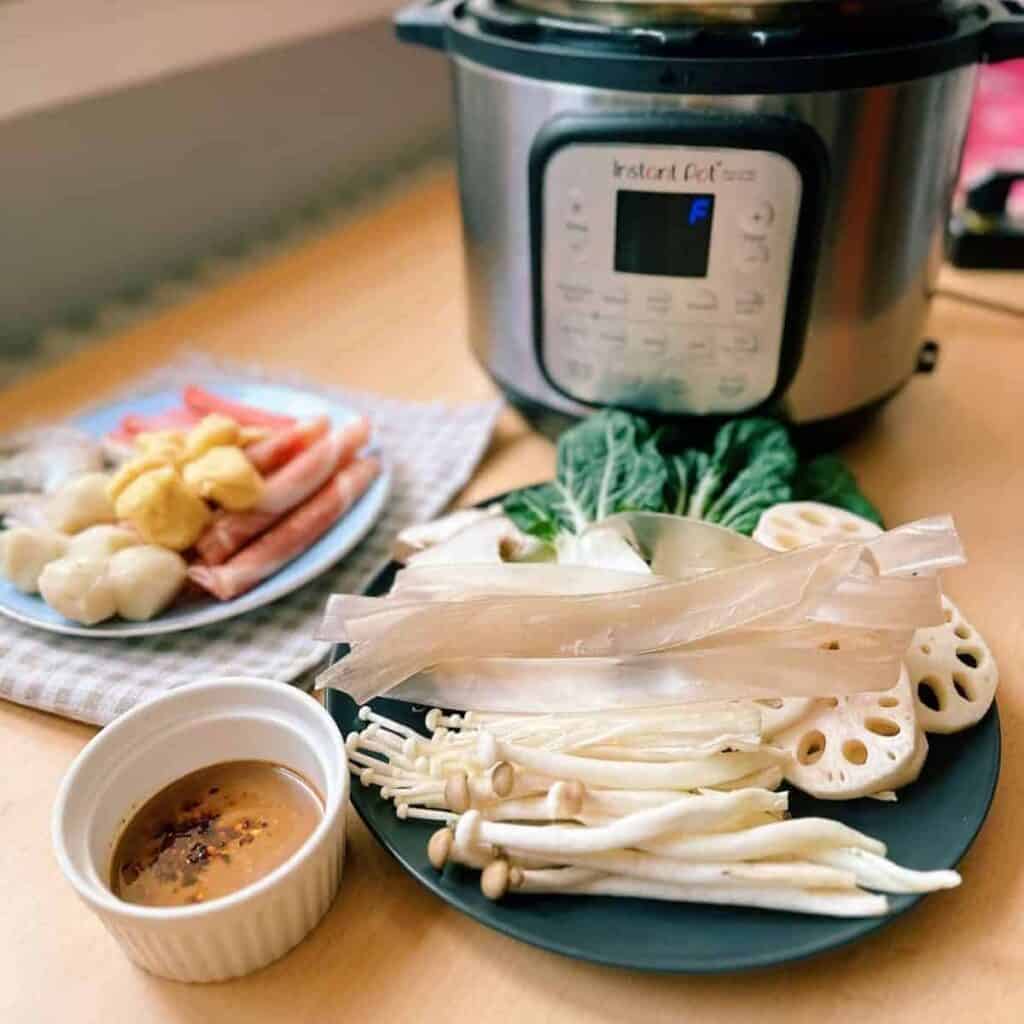
There appears to be a typo? Says to cook for ZERO mins.
“– For chicken leg quarters/thighs: Cook for 0 minutes, then allow for a natural release for 10-15 minutes.”
How long should the leg quarters/thighs be cooked in the Instant Pot? Thanks!
It’s not a typo :). The Zero minute cooking still takes around 35-40 minutes in total (25 minutes for the instant pot to get up to pressure and 10-15 minutes to release the pressure). You could find more in this video: https://www.youtube.com/watch?v=Y7Cuayyn7JA
Hope this clarifies things for you!